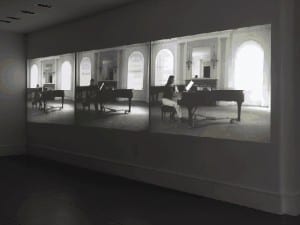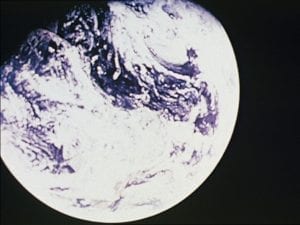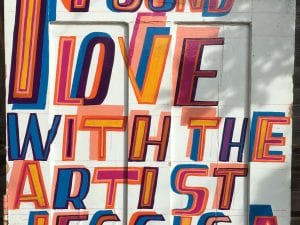A new retrospective of the work of this conceptual artist at the Museum of Modern Art in New York unravels the parade of contemporary media and consumer culture.
In his landmark 1967 book, the Situationist philosopher and cultural theorist Guy Debord wrote that “the spectacle is not a collection of images, but a social relation among people, mediated by images.” At many places in that text, Debord makes the case that through understanding the ways our media culture obscures social relations between people in favour of the simplistic relation of consumer and commodity, it is possible to upset the balance of commodity fetishism associated with late capitalism. As a new exhibition, Christopher Williams: The Production Line of Happiness, at the Museum of Modern Art in New York suggests, perhaps no artist has done more over the last 30 years to explore the specific “social relations among people” that our image culture and media embody and conceal than the American-born and Düsseldorf-based conceptual artist Christopher Williams (b. 1956).
The exhibition title, The Production Line of Happiness, could quite easily pass for an utterance of Debord, but in fact it hails from a film by an artist who had a troubled relationship with the Situationists: Jean-Luc Godard. It focuses on an amateur filmmaker who compares his daily job as a factory worker with his hobby of editing his portrayal of the Swiss countryside as “the production line of happiness.” In relation to Williams’ work, though, the title takes on deep inflections of the political and social role of photography as it is used across much of contemporary media culture. This memorable phrase crystallises the role of the art form as something which has become employed to sell commodities and to promise the product of “happiness” .
Williams was a student at the influential California Institute of the Arts in the mid to late 1970s in a period when it was a hotbed for conceptual art, with Williams’ teachers including John Baldessari, Douglas Huebler and Michael Asher. As this is the first major museum retrospective of Williams’ work, the curators have chosen to explore a wide range of his practice, including some of his earliest creations. The series SOURCE… (1981), for example, was Williams’ MFA thesis. For this, Williams set two criteria and then selected a series of images from the John F Kennedy Photographic Archive, a procedure that is described in detail in the full 120-word title for the project. The criteria Williams decided upon were that the images must be from a single day, 10 May 1963, and that they must show President Kennedy with his back towards the camera. The examination, subversion and interrogation of the function of images can be seen in Williams’ appropriative and curatorial working method in this series, which is often to work with existing photographic sources and examine aspects of their production and social values.
The resulting sequence of pictures has a haunting quality because of the knowledge that later the same year the President will be assassinated. In one sense, the camera could be seen as an imaginary target-finder, surveying the President when he is vulnerable and unaware of being watched. However, Williams seems equally interested in subverting the traditional projected imagery of Kennedy as icon. By showing Kennedy with his back turned to the camera, Williams reminds the viewer that he wasn’t just a two-dimensional image as portrayed by the visage shots used in thousands of magazines, newspapers, TV reports and elsewhere. By showing the President with his
back turned and from an angle that the media have chosen not to use, SOURCE… reminds us that as well as an image, Kennedy was a person.
In this and later work, Williams leaves his artistic intentions extremely open. There doesn’t seem to be any single or clearly articulated purpose behind the procedure he adopts. Rather, he produces these pieces as a way of opening up conversation and encouraging attention to be paid to the processes of contemporary media and art. As curator Roxana Marcoci remarks: “For Williams, every artistic production is a sort of dialogic enterprise in which he engenders a conversation with creatives of his generation, his predecessors and artists of the younger generation.” In works such as Bouquet, for Bas Jan Ader and Christopher D’Arcangelo (1991), for example, Williams engages with the works and legacies of these two tragic figures of conceptual art, both dying young in suicides. Williams’ piece is a photograph of a bouquet of carefully constructed wooden flowers, shot on a white table cloth and with a black background, recalling traditional still life paintings and photography. A meditation on death, life and legacy, Williams’ piece is also a complex exploration of artifice: the flowers are made by the artist to look like they are close to dying and the photograph is stylistically shot to create a mood of mourning and tribute. It suggests the artificiality of notions of artistic legacy and endurance while also suggesting the unpredictable and fleeting qualities of life.
One element of the conversation that Williams opens up through his works is a dialogue between photography and filmmaking, which has lead Marcoci to call him a “cinephilic” photographer. To illustrate this aspect of his artistic practice, The Production Line of Happiness features a series of rarely shown short films shot on a Super-8 camera, made while he was a student, and also features a series of experimental short films curated by the artist. For the series of films, Williams was given a “carte blanche” and has chosen a selection that includes artists such as Tony Conrad, Andy Warhol, Rainer Werner Fassbinder and Harun Farocki, among others.
From 1993 until 2001, Williams worked on a series entitled For Example: Die Welt ist schön, which translates as The world is beautiful. These pieces explore what Williams has called “an essay on modernity and modernisation.” As Marcoci explains: “The point of departure for this series was an influential book from 1928 by Albert Renger-Patszch entitled Die Welt ist schön which featured a wide range of photographs of natural and human creations.” Indeed Williams himself travels across the world taking photographs of a similarly diverse range of subjects, including a pristine tropical beach in a tourist resort in Cuba, an upturned Renault automobile from 1964 and a dishwasher opened up from the back rather than the front. In many ways his style draws on traditional landscape and still life while referencing the aesthetic associated with product and marketing photography.
As Marcoci notes, the remarkable depth of resonance in these works includes many subjects that form the significant crux of Williams’ art, including “the Cold War, various histories of avant-garde art, the after effects of decolonisation and many other issues.” Of course, there is a significant political and social commentary embodied in the choices and decisions he makes regarding the subjects he includes. For example, the Renault car is, in some senses, a symbol of the social upheaval and transformation of Paris in 1968. And, as Cuba is one of the few remaining Communist states, there is of course an irony and tension in the way it has become a popular luxury travel resort for foreign tourists.
While Williams’ output is primarily associated with photography, he has also practised across other art forms and his work is relevant to a varied range of artistic traditions and media. For example, he has also worked on a series of vinyl supergraphics. These pieces feature large-scale text printed on coloured backgrounds, mimicking forms of advertising and shop-window displays. As with many of his photographs, these works demonstrate Williams’ extremely sly and cunning sense of humour, in which he constantly pokes fun at the institutions of media and art culture while also engendering serious debate on the political and social implications of their output.
Since 2003 until the present day, Williams has produced another major series, For Example: Dix-huit leçons sur la société industrielle, which translates as Eighteen Lessons on Industrial Society. The title of this series also references a book, in this case a 1963 text on modes of production by the French sociologist Raymond Aron. In these shots, Williams examines the mechanism and apparatus of photography itself, the camera taking centre stage. In an almost cannibalistic way, Cutaway Model Nikon EM (2008) shows a Nikon camera cross-sectioned down the middle to reveal its inner workings, and Changing the shutter speed (2012) shows the hands of a photographer on the mechanism of the camera doing as the title of the work suggests.
In these works, Williams consciously breaks the spell of photographic imagery, demonstrating the techniques and modes of production that make the kinds of images we see in magazines, newspapers and indeed galleries possible. The photographic spell, though, stretches beyond the confines of the camera itself and into questions of the labour involved in creating images. The series therefore also includes works in which models are seen posing next to colour charts and other tools that are used by photographers to achieve particular effects. Linhof Technika V fabricated in Munich (2008) features a camera seen from the back, through which the upside-down torso of a woman is visible. She is wearing a bra and binder clips, a feature of the image that would naturally not make it into the final version of a commercial photograph used for marketing purposes.
In many of his photographs, Williams makes use of an almost filmic apparatus of assistants, locations, sets and props. He consciously recreates some of the high tech and highly sophisticated procedures of marketing photography and Hollywood movie. Having grown up in a family associated with the film industry, it is a way of working with which he has a certain degree of familiarity and a great deal of ironic engagement. His pictorial aesthetic is as pristine as many of the greats of magazine commercial photography, but his ends are far more subversive, using the tools of the industry to expose many of its social realities. He does this by allowing small details or “blemishes” to reveal themselves even in his highly stylish images. In one, for example, there will be dirt on the undersole of a model’s foot. In another, the label of a pair of underpants is aligned amusingly skewed next to a buttock. In other pictures fingernails, are seen cut extremely almost unnaturally short, as if to portray/convey a sense of “nail biting” or the anxiety associated with body image and contemporary consumer culture. Williams’ work is able to employ the mechanisms of contemporary photographic culture to expose the almost comedic hollowness and emptiness of the process of commodification which makes impossible genuine human relationships and emotional interactions.
These images are heavily saturated with the bright colours and pop aesthetic of 20th century Pop Art, created by artists who were both sceptical of and mesmerised by the rapid commodification of culture and media that took place alongside the Cold War. With the resurgence of tension between Russia and the United States in 2014, due to the unfolding situation in Ukraine, the timing of this exhibition could not be more appropriate.
As an American artist based in Düsseldorf, Williams has a particularly interesting perspective on the ways in which photography and media culture are used to define a particular set of aesthetic values against those associated with an adversarial and contrasting social model. As Marcoci comments: “Williams’ critique spans both authoritarian regimes and political situations, and the capitalist democracies of Western Europe and the USA.”
By breaking the spell of the photographic industry and media culture, Williams, in effect, dismantles certain aspects of Debord’s “society of the spectacle”, helping to reveal some of the social relations that photographic imagery and media culture attempt to obfuscate, disguise and cover over in favour of presenting the pristine images associated with contemporary consumerism. These include injustices such as the objectification of women in the media and the inequalities which are manifest between photographic assistants, photographers and models. By displaying the mechanisms and tools of his art, Williams points to a possible way of subverting and freeing oneself from its overwhelming media implications.
Christopher Williams: The Production Line of Happiness runs until 2 November at Museum of Modern Art in New York. www.moma.org.
Colin Herd





